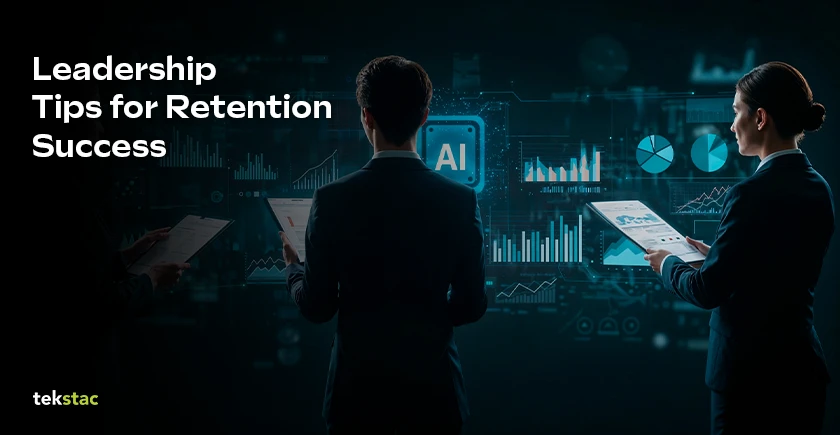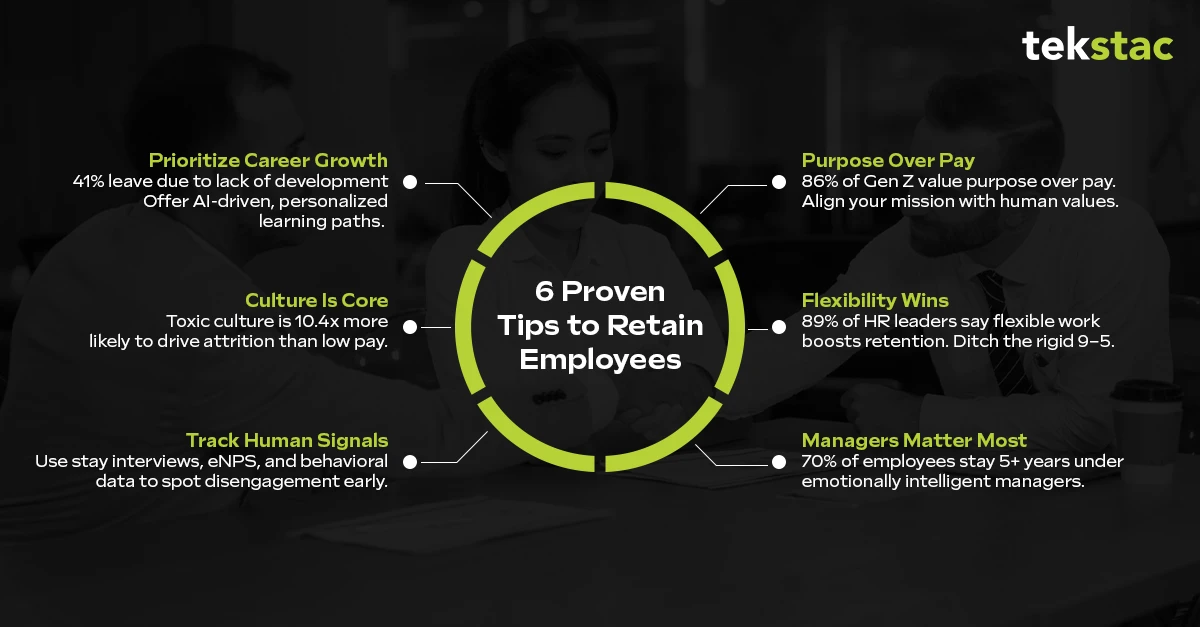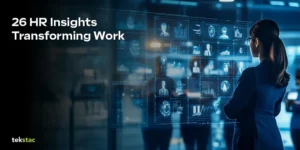How to Drive Employee Retention: 6 Tips for Leaders

It’s no longer a theory. In 2026, the crisis of employee retention has become the defining challenge of the modern workplace. While market fluctuations and digital disruption still demand attention, they are increasingly overshadowed by a deeper threat: human disengagement.
Gallup’s latest workplace report sounds the alarm with a single statistic one in two U.S. employees is actively considering an exit from their current role. This signals an urgent employee retention crisis, where organizations that fail to address it are not just risking turnover—they’re risking collapse from the inside out.
Employee Retention Challenges in 2026: Burnout and Disengagement
The crisis deepens when you realize that it is not industry-specific. Healthcare, tech, finance, and education are all experiencing record-breaking turnover.
- 66% of U.S. employees report experiencing job burnout, highlighting a major obstacle to employee retention. This rise is linked to return-to-office stress and unrealistic performance expectations.
- 28% of employees are planning to “revenge quit” due to burnout, feeling undervalued, and lack of upward mobility.
- 65% of professionals feel “stuck” in their current roles, a leading driver of dissatisfaction and spontaneous resignation.
- 68% of Gen Z and 61% of millennials report being burned out, indicating a serious generational retention crisis.
Employees are not just checking out. They are burning out, making employee retention harder than ever. Employees attribute their mental health struggles directly to their workplace. Poor managers and toxic cultures are cited more often than any other factor.
AI Insight: Predictive analytics can now forecast employee attrition up to 6 months in advance based on behavioral and engagement data.
6 Proven Ways Leaders Can Boost Employee Retention

1. How Purpose Drives Employee Retention
The smartest leaders in 2026 know one truth. People no longer work just to survive, they work to matter. You cannot build loyalty or ensure employee retention with salaries alone. People want to be part of something that reflects who they are.
If your company stands for nothing beyond revenue, you will attract mercenaries. But if it stands for something meaningful, you will build an army of believers.
- Only 21 percent of employees globally are engaged at work in 2025. That disengagement is costing businesses a shocking 438 billion dollars in lost productivity
- Deloitte’s research shows companies with a clear purpose have 40 percent higher retention. That is not marketing, that is survival
- Deloitte’s 2024 Gen Z and Millennial Survey found that 86% of Gen Z and 89% of millennials say purpose is not a bonus, it is a basic expectation.
2. Flexible Work Models That Improve Employee Retention
The traditional 9-to-5 office model has become obsolete. Rigid work policies are no longer sustainable, as they contribute to higher attrition rates.
Consider these key insights:
- According to a SHRM study, flexible work arrangements boost recruitment, retention, productivity, and employee engagement, while also supporting work-life balance and cost savings.
- A Paycor report indicates that 51% of U.S. employees are actively looking for new jobs, with flexible schedules ranked as the top reason employees stay in a role.
- Robert Half’s analysis reveals that hybrid job postings increased from 9% in Q1 2023 to nearly 23% by the end of 2024, signifying a shift towards flexible work models.
- A Flex Jobs survey found that 89% of HR professionals observed increased retention after implementing flexible work policies.
3. How Managers Influence Employee Retention and Engagement
In 2025, the role of managers has evolved beyond traditional oversight. They are now pivotal in shaping employee experiences and retention. Emotionally intelligent leadership is no longer a luxury but a necessity.
- Managers with high emotional intelligence retain 70% of their employees for five years or more, as highlighted in the 2025 Global Culture Report.
- Toxic leadership environments have been linked to a 66% increase in job burnout, according to a Forbes study.
- Employees who feel heard by their managers are 4.6 times more likely to stay, emphasizing the importance of active listening in leadership.
Leadership must transition from authority-based models to empathy-driven approaches. Managerial KPIs should encompass team well-being alongside performance metrics.
In today’s workplace, effective leadership and employee retention are intrinsically linked.
4. Career Growth Strategies That Strengthen Employee Retention
- A Harvard Business Review article emphasizes that high performers are often overlooked in development programs, leading to disengagement and attrition.
- According to McKinsey, 41% of employees cite lack of career development as a primary reason for leaving.
- Implement AI-driven learning paths, monthly feedback sessions, and internal mobility platforms to foster continuous growth.
- Offer micro-certifications and mentorship programs to support skill development and career progression.
Investing in personalized development strategies not only enhances employee satisfaction but also significantly reduces attrition rates.
5.Company Culture and Its Impact on Employee Retention
In 2026, culture isn’t a side note. It’s the core strategy. You can’t patch a toxic environment with perks or pay raises.
When people sense distrust, bias, or disconnection, they leave.
A toxic workplace is 10.4 times more predictive of attrition than low compensation.
6. Using Data and Analytics to Boost Employee Retention
In 2025, data doesn’t just belong to customers. It belongs to employees too. Smart organizations are using behavioral analytics and AI to identify disengagement before it becomes departure.
Use data for
- Notice when employees avoid taking time off or are consistently overloaded
- Stay interviews to understand why employees are still here
- Employee Net Promoter Scores tracked quarterly
- Transparent compensation benchmarking to reduce exit surprises
How Tekstac Improves Employee Retention Through AI-Powered Learning
Retention isn’t a mystery. It’s a model. And Tekstac is the platform turning this model into results. Tekstac enables organizations to personalize growth, identify skill gaps, and align learning with business outcomes through AI-powered career mapping, immersive Practice Labs, and performance dashboards that connect development with delivery.
Tekstac stands at the forefront of AI trends in skilling, bringing the latest innovations in adaptive learning, personalized upskilling, and real-time skills tracking into the corporate environment.
It supports the broader digital and talent transformation in L&D, helping organizations shift from static training modules to dynamic, scalable, and employee-centered learning ecosystems.
Tekstac is not just a training solution. It is a talent ecosystem. With intelligent analytics, it gives leaders real-time clarity on performance, progression, and potential.
Your Role in Driving Employee Retention
The game has changed. Employees are no longer waiting for your strategy. They are evaluating it. If your systems are rigid, if your managers are untrained, if your culture is performative, your best people will walk.
Now is not the time for temporary fixes. It’s the time for transformation
- Build purpose into the employee experience
- Redesign flexibility around human rhythms
- Retrain managers as coaches
- Personalize learning at scale
- Make culture breathable and safe
- Use data to lead, not just react
These are not trends. These are the new table stakes. If you want to retain, you need to become worthy of retention.
FAQs on Employee Retention
1. How do I calculate employee retention?
Employee retention is calculated by dividing the number of employees who remain at the end of a period by the number at the start, then multiplying by 100. A higher percentage indicates stronger retention.
2. How can AI improve employee retention?
AI helps predict attrition risks, personalize learning paths, and identify disengagement early enabling leaders to act proactively and improve employee retention.
3. What drives employee retention?
Key drivers include purpose-driven work, flexible policies, career growth, supportive managers, and a positive company culture that values employee well-being.
4. How can company culture reduce turnover?
A healthy culture that promotes trust, inclusion, and recognition creates belonging—reducing burnout, boosting engagement, and naturally improving retention.





